 This information has been archived for reference or research purposes.
This information has been archived for reference or research purposes.
Archived Content
Information identified as archived on the Web is for reference, research or recordkeeping purposes. It has not been altered or updated after the date of archiving. Web pages that are archived on the Web are not subject to the Government of Canada Web Standards. As per the Communications Policy of the Government of Canada, you can request alternate formats on the "Contact Us" page.
Book Review Essay
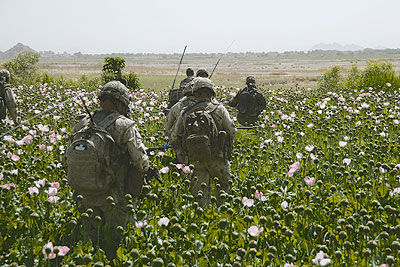
DND photo AR2008-Z140-07
Canada and New Paradigms of War
by Michael Goodspeed
For more information on accessing this file, please visit our help page.
Introduction
At a recent high-profile public conference on peacebuilding in Afghanistan, I was struck by the shared views of three sincere and passionate Canadians: a federal politician, an aid worker, and an academic, all of whom ardently expressed the view that violent extremism and instability in Afghanistan would somehow disappear if only the Canadian Army and its NATO allies would leave. At this particular symposium, these individuals were a decided minority. Nonetheless, they represent a point of view that resonates with a considerable segment in mainstream Canada and elsewhere in the Western world. It would seem, viewed from this particular school of thought, that war is instigated and enabled by the very presence of armed forces. And to give this group its due, in dozens of conflicts across the globe this has often held true. However, in the case of the Afghan war, for those less influenced by dogma, the available evidence suggests that the presence of foreign armed forces is a symptom of more profound societal problems rather than being an underlying cause. Yet, it would be wise not to dismiss too lightly popular hazily defined pacifist explanations of the cause and cures for modern war. Even among those who believe violent insurgencies must be defeated by tempering force with development aid, there is no agreed-upon balance between the two methods of restoring peace and stability. Differences between modern western pacifists and those who countenance the use of force are not simply questions of perception; such differences are almost certainly a reflection of profoundly different philosophical convictions.
In the main, for those who make their profession the study of modern warfare, there would seem to be a high degree of consistency in their philosophical outlook toward war. Yet, it is equally true that among those who accept the use of force as a viable means of creating peace and stability, there are noticeable differences in their perceptions of events, and, as a result, their predictions of the future. In the past decade, influential books by such diverse authors as Rupert Smith, Max Boot, Martin Van Creveld, Thomas Hammes, Richard Simpkin, Ralph Peters, John Keegan, and even Alvin and Heidi Toffler amply illustrate that there is no single agreed-upon view as to what future wars will be like. This essay will examine several of the new proposed paradigms, and discuss how these interpretations of 21st Century warfare might affect Canada.
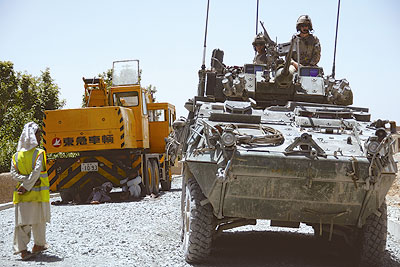
DND photo AR2008-Z139-13
The Utility of Force
In what is arguably the most original and carefully argued of these books, the British General Sir Rupert Smith contends in The Utility of Force that the nature of war has changed, and wars no longer result in clear-cut victories with an ensuing peace.1 Instead, wars have become a prolonged, cyclical process, which leads to an endless form of violent instability. Whether you agree with Smith or not, his book raises a number of important issues about modern war and the nature of future conflict. Smith believes that warfare has evolved from its industrial phase wherein war was waged between nation-states, to what he terms War Amongst the People. Smith encapsulates these observations in six salient features of such a war. “The ends for which we fight are changing from the hard objectives that decide a political outcome to those of establishing conditions in which the outcome may be decided.” In this variant of Clausewitz’s most famous dictum, Smith contends that war has become less a means of forcing a decision and more an ancillary process, which merely shapes and influences the environment in which conflict will be resolved. “We fight among the people, not on the battlefield.” True to his lengthy experience in counter-insurgency, Smith has modified Mao Tse Tung’s maxim on guerrilla warfare. But Smith takes Mao a step further, declaring that, “War is timeless, even unending.” And in this, he gives new life to the Orwellian and Leninist views of the future in which war is seen, not as a temporary aberration, but as a constant feature of the human condition.
As a corollary of war’s new perpetual nature, Smith observes that the new form of conflict necessarily entails a cautious approach to violence, wherein, “We fight so as to preserve the force rather than risking all to gain the objective.” And in the true adaptive style of the guerrilla, tactics, logistics, and organizations are recycled as new tools of warfare. “On each occasion new uses are found for old weapons and organizations which are the products of industrial war.”
Lastly, we have Smith’s final distinguishing feature of War Amongst the People: “The sides are mostly non-state, comprising some form of multinational grouping against some non-state party or parties.” In this, Smith observes upon the new realities that have characterized low intensity conflict since the days of the National Liberation Front (FLN) in Algeria and virtually every asymmetrical conflict of the last sixty years.
Smith’s observations undoubtedly are useful, but there are important areas that he has not explored. For example, his paradigm also works for the present, a period in which weapons of mass destruction have, for now, seemingly been contained. However, it is not realistic simply to assume that the advent of nuclear weapons has made war between nations too dangerous to contemplate. Correspondingly, war amongst the people will very likely entail the use of weapons of mass destruction in the future. After all, the 9/11 strikes were improvised weapons of mass destruction (WMDs), and it is probable that similarly novel innovations can be used again with the very real and horrific prospect of retaliation in kind. This raises the real possibility of escalation, from war amongst the people to a higher and more intensely violent kind of warfare. This almost certainly would entail escalation to some type of conflict between states. Sub-national conflict has, in the past, precipitated global conflict, as the assassination of the Austrian Archduke Franz Ferdinand all too catastrophically proved in 1914.
Moreover, Smith assumes that most conflict will be inherently asymmetrical in nature. This may not be the case, and it would be wrong to predict the future based upon Western experience of the very recent past. Other nations and cultures will almost certainly develop and become capable of challenging the West; and in such cases, as in the Cold War, the prospect of interstate war by proxy becomes a real possibility. Furthermore, an assumption of perpetual asymmetry ignores the possibility of future coalitions, or, as is entirely possible, an unforeseen weakening in the West. The assumption of perpetual asymmetry certainly begs the question if this is not really some form of wishful thinking – a shortcoming that has historically proven to be one of the most common and grievous of intelligence failings.
Again, Smith has deliberately chosen to steer clear of the moral dimension of war, and this is a limitation of his work. For in doing so, he appears to assume that potential belligerents view war and its attendant risks from a similar perspective. Religious beliefs can have an enormous impact on future war, and enemies who regard death in battle as a form of martyrdom and a passport to paradise may well be likely to gamble with the fate of innocent and unsuspecting civil populations in furthering their sacred causes. Even the threat of this kind of war couldtrigger an escalation of violence beyond War Amongst the People.
Despite these relatively minor criticisms of Smith’s work, his analysis provides a revealing description and highly profitable insight into the kind of conflict in which the West has increasingly found itself involved.
War Made New
On the other hand, in the book War Made New, Max Boot surveys the history of technological development in war, and comes to the somewhat obvious conclusion that nations may be capable of developing technical and tactical advantages, but, to be successful, they must understand these developments in light of their armed forces’ strengths and weaknesses, and the larger strategic context.2 Boot argues that the limits of force are constrained by the capabilities and limitations of armed forces – and that understanding those parameters requires wisdom and insight.
According to Boot’s assessment, there have been four major revolutions in war: the Gunpowder Revolution, the First and Second Industrial Revolutions, and the Information Revolution. The bulk of War Made New is a well-written but not particularly original analysis devoted to providing historical proof that technology alone is not a decisive advantage in waging a successful war.
However, what Boot lacks in originality he more than compensates for with his book’s timeliness, the breadth of his historical samplings, an engaging writing style, and his assessment of the Information Revolution. Boot’s examination of military technology in the larger sweep of history is valuable, especially if one contrasts his analysis with the West’s current psychological and cultural vulnerabilities: belief in technology, impatience, sensitivity to casualties, and pervasive but hazily defined pacifist sentiments. Each of these vulnerabilities is attitudinal, rather than technical or strategic. And if one considers these within the context of Boot’s overriding theme that a blinded outlook can prove a greater and more dangerous shortcoming than any advantage provided by technological supremacy, they assume a troubling relevance.3
The Transformation of War
Martin Van Creveld was one of the most popular exponents of the view that the very nature of warfare has altered dramatically – not merely because of the changes in the weapons being used, but more importantly, as a result of the decline in the importance of the nation-state in prosecuting trans-national Low Intensity Conflict. He articulated these views in several influential articles and in his highly esteemed and still popular 1991 book, The Transformation of War.4 Van Creveld argued that the free flow of ideas and the rise of trans-national terrorism and other factors have precipitated a decline in the importance of the nation-state as a focus for winning the new wars of the 21st Century. This, in turn, has meant that the Clausewitzian Universe, in which the nation-state was a defining concept – and one from which the West framed its thinking about war – has now become largely irrelevant.
War, Van Creveld claimed, will not disappear, but the nature of conflict will transform into a series of prolonged slow-boiling Low Intensity Conflicts. He further maintains that conventional standing armies should be replaced by forces more suited for fighting the Low Intensity Conflicts that will be fought in the future. Van Creveld cites the trans-national Jihadist conflict that characterizes the violence in the Middle East as an archetype of this new kind of war.
In many respects the six principles Smith proposes in his Utility of Force are extensions and revisions of Van Creveld’s thinking, which, in turn, was a major expansion of the popular view espoused a generation ago by John Keegan in his conclusions to The Face of Battle.5 Keegan argued that war, because of its increasingly ruinous potential, was rapidly becoming obsolete. History has already proven Keegan wrong, as mankind has steadfastly refused to renounce violence as a means of securing its aims. Instead, as this group of writers affirms, because of modern war’s doomsday potential, changes in the character of inter-state relations and the lopsided nature of post-modern power and wealth, war has transformed. War is moving down the scale of violence, and is resurfacing in a new form as a much more prolonged low-intensity struggle designed to undermine one’s opponent, sap his resolve, and create the moral and intellectual circumstances to allow for the triumph of another competing ideology.
Although there is a good deal of truth in this line of thinking, there are also several problems associated with it. Firstly, the contention that the nation-state is becoming less important as a security, administrative, or cultural focus is almost certainly inaccurate. Undeniably, the role of the nation-state is changing. However, in virtually every corner of the world, nation-states remain as viable and essential institutions that manage the provision of vital services. They are the crucial organizations for defining a population’s laws and for preserving its security and culture. And they continue to act as the guardian of its inhabitants’ values. This remains as true across the Islamic world as it does in the European Union. What Van Creveld, Smith, and even Keegan discount is that violent trans-national ideologies, be they secular or religious, ultimately seek to attack and transform the structure of individual states. And while wars may be fought by trans-national dissident groups and insurgents, one of the key aims of war that remains is changing the nature of a particular state or group of states. These are ambitious goals, and to realize them takes organization, financing, coherent leadership, mass, and secure base areas from which to prosecute campaigns. Even in a digitized world, a successful terrorist organization that aspires to grow beyond being an isolated and violent pressure group needs the support and backing that only a nation-state can provide. If trans-national terror aspires to become anything more than a deadlier form of international crime, it needs a state sponsor to allow it to grow. In turn, states that sponsor terrorism will become the targets of those who are attacked by terrorists. In this manner, the possibility of inter-state war remains as a probable outcome of 21st Century conflict.
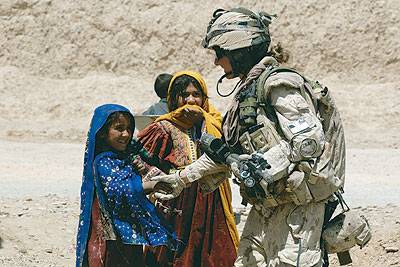
DND photo AR2008-Z139-21
The Future of Inter-State War
Far from disappearing, inter-state war will linger as a deadly peril that remains closely linked to Low Intensity Conflicts, as was proven by the American invasion of Afghanistan, where war erupted as a result of a national government supporting trans-national terrorism. In this sense, it is clear that the exposure of covert national support to trans-national terrorism almost certainly increases the likelihood of inter-state war. What the world is witnessing is not a new phenomenon. The environment and the methods for spreading a new threatening ideology are unquestionably different, but the strategic conditions for the propagation of violent subversive ideologies are, in many respects, similar to the circumstances of a century ago.
The “withering away of the state” was a 19th Century Marxist concept that proved to be as mistaken then as it is now in its newer incarnation. The implication of this is that states will remain instrumental in battling and supporting destabilizing trans-national ideologies. Destabilizing ideologies will not survive long, nor prove to be much of a threat outside the incubator of national support. Islamic Jihadism, for example, is almost certainly in a position similar to that of communist ideology prior to it finding a Soviet home with the Russian Revolution.6 However, where the aforementioned authors are probably correct is in identifying new dimensions of war that take advantage of porous international borders and new physical vulnerabilities, which, in turn, have developed from new communications technologies, freer and more accessible international transportation, and modern weaponry.
Clearly, the phenomenon of inter-state war cannot be relegated to anthropological or military history. Although it is for the time being diminishing in frequency, as a concept, inter-state war remains a dynamic and menacing form of conflict. At present, it has shifted to the margins and away from developed states, many of which possess their own weapons of mass destruction. As both Van Creveld and Smith point out, the existence of several states possessing WMD has certainly diminished the likelihood of inter-state war in Europe and elsewhere, but this phenomenon has also been concurrently driven by widespread acceptance of democracy, improved mass communications, and the existence of international governing bodies, such as the United Nations (UN) and the European Union (EU). WMD, along with these other major transformations, have conspired to make war between the developed nations less likely. But these constraints do not provide any guarantees of preventing inter-state war between, and with, less developed nations; nor do they influence the possible spread of instability and war as a result of inter-state wars waged between major and minor powers.
Sadly, neither the scale nor the nature of armed conflict is shrinking. Ideologically motivated, trans-national low-intensity conflict is simply an additional threat that extends rather than reduces the possible spectrum of modern violence.
The Sling and the Stone
Of the principal writers on future warfare, certainly one of the most prescient has been the US Marine Corps’ Colonel Thomas Hammes. In his 2004 book, The Sling and the Stone,7 Hammes suggests that the nature of current and future conflict has evolved into a more sophisticated and subtle form of combat. “The fourth generation has arrived. It uses all available networks – political, economic, social and military – to convince the enemy’s political decision makers that their strategic goals are either unachievable or too costly for the perceived benefit.”8 Hammes’s views on the fourth generation of warfare share much of the same intellectual space as do Smith and Van Creveld, particularly with respect to his disdain for what he regards as the West’s near-compulsive belief in technical solutions to military problems. Hammes also shares the view with the Smith and Van Creveld schools of thought that warfare will, in the main, be low intensity and prolonged: future wars will be measured in decades, not years, as was the case in most industrial-era wars. In comparison to Smith and Van Creveld, Hammes’s approach to this form of war is less dogmatic, more imaginative, and less restrictive. He also presents a convincing practical case for addressing many of the root causes for the problems generated by the West’s, and, in particular, America’s, belief in technological solutions to military problems.
Hammes’s characterization of the Four Generations of warfare differs in some important respects from Max Boot’s Four Revolutions. Hammes’s four generations of war are essentially reduced to a linear era, an era based upon firepower, an era based upon manoeuvre, and an era of multi-dimensional, non-state warfare. The first three can be roughly equated to Boot’s categories, but the crucial difference lies in Hammes’s Fourth Generation Warfare. For Hammes sees, as do Smith and Van Creveld, future war having an enormous similarity to what we have come to regard as conventional insurgency.9 Hammes has identified the most likely kind of future warfare to be insurgencies, enabled by modern technology, and striking at our psychological vulnerabilities. While the likelihood of insurgency being the most probable kind of war we are going to encounter is not in dispute, Max Boot’s fourth Information Revolution is nonetheless the more appropriate categorization, simply because Boot’s take on this does not channel thinking to one specific form of warfare. The concept of an Information Revolution or Information Age War implicitly includes other levels of conflict intensity and the possibility of war between states. Boot’s emphasis on the larger societal discontinuity as being the overriding factor in warfare also allows his theoretical framework to include the entire spectrum of conflict. And, equally as important, it allows for the full range of possibilities afforded by the Revolution in Military Affairs and Network Centric Warfare – both of which were recent buzzwords that now seem embarrassingly outdated, but, nonetheless, retain a degree of meaning that is not contained in Hammes’s newer catchphrase, Fourth Generation Warfare.
Hammes is quite specific as to the actions needed to prosecute fourth generation warfare successfully – and his solutions are not at all dissimilar to the much scorned opinions of the popular futurists Alvin and Heidi Toffler. More than a decade before Hammes, the Tofflers wrote about the changes Third Wave technological innovations were driving in warfare.10 The Tofflers, apart from their fixation on developing technologies, further argued that future war would be driven by much flatter command structures, less bureaucracy, and more responsive and direct institutional leadership. Hammes, in turn, is emphatic with respect to the need for development of clear, flexible thinking among political and military leaders, and the requirement for fewer commanders supported by lean, highly skilled staffs. He is unequivocal in his demand for reducing and streamlining the industrial age bureaucracies of modern armed forces.
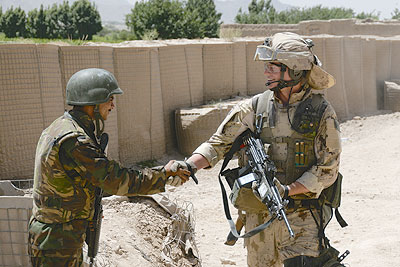
DND photo AR2008-Z139-22
Some Closing Thoughts
From this examination of contemporary views on the nature of war, it is evident that, in the recent past, there have been no truly revolutionary discoveries or startling leaps in thinking. The central ideas these thinkers propose are almost all variations and gradual developments of broadly shared and evolving concepts. Outside the realm of weapons technology, which has witnessed remarkable discontinuities, most current military thinking would seem to have been largely an incremental progression, a feature that some commentators have sneered at because of the derivative nature of the process.11 This is not a serious or compelling criticism; in truth, it is probably a strength. All innovation is ultimately derivative, and the process of understanding such a complex and problematical subject rightfully entails lengthy debate and deliberation.
In Canada, the debate with respect to the nature of future war and how it affects our long-term security seems to be somewhat muted. What debate there is tends to be rigorously tactical or technical in nature, and the subject is infrequently, if ever, raised outside the Canadian Forces. At the same time, our armed forces are undergoing a period of transformation involving change at least as dramatic as anything since Paul Hellyer’s experiment in enforced unification. Thus, if we agree that the larger developments in modern war herald both a change in emphasis in the kinds of war, and, at the same time, represent an extension rather than a reduction in the spectrum of possible conflict, then what does this mean for Canada and the nature of the CF’s transformation?
Should Canada prepare itself for a niche security role solely in the field of Low Intensity Conflict and peacekeeping, and with it, accept a niche position on the world stage? Should she arm herself with light, highly mobile, high-technology multi-purpose land, sea, and air forces capable of operating across the conflict spectrum, as Richard Simpkin proposed NATO forces should be structured in his visionary and influential 1985 book Race to the Swift?12 Or should we steer some kind of middle course so that we can engage selectively in a range of expeditionary operations with a larger and more capable ally? These are not simply Canadian Forces problems of doctrine, acquisition, and organization. They are also issues that deserve vigorous national debate, as they are instrumental in defining who we are as a nation and as a people.
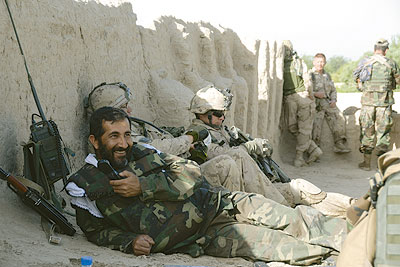
DND photo AR2008-2140-04
From a Canadian perspective, we should perhaps in addition to these questions be asking ourselves if the larger debate on the nature of conflict is in accord with our view of the world. If this review of some of the major writers on contemporary warfare is any indication, should we not be asking ourselves if the current debate with respect to the nature of conflict is comprehensive enough? Can war continue to be regarded by armed forces and governments as merely that stage of international conflict that involves combat? Should Canada and the Canadian Forces also be looking at the military’s role in the phases of conflict preceding and following combat?
This is not a far-fetched concept. Military forces around the globe are already involved in security sector reform, peacekeeping, and reconstruction operations, and our own broad experience in Afghanistan and in so many other parts of the world gives us credibility as one of the world leaders in such operations. In addition, Canada has, over many decades, supported the notion of providing military expertise, training, and education in support of developing stable and reliable nations in the Third World. If it is correct, as this review of contemporary thinking suggests, that our view of the conflict spectrum is too limited, the CF should give these issues more emphasis in our education and training, and doctrinally embrace the obligation to prepare for operations in pre-combat and post-combat situations as a shared responsibility with other government departments.
Developing useful and permanent capabilities in the pre- and post-combat areas of the conflict spectrum need not involve large numbers of troops, the creation of large staffs, or the development of new bureaucracies. It will, however, require a change in mindset, a comprehensive re-evaluation of the senior officer’s professional development syllabus, and greater cooperation and coordination with other government departments: most notably, Foreign Affairs, the Canadian Security Intelligence Service (CSIS), and the Canadian International Development Agency (CIDA). This is an attainable goal, as successive Canadian governments have theoretically authorized the notion of a much more proactive national stance in the area of integrated Whole of Government expeditionary operations. As a consequence, these coordinated endeavours should begin with a tailored inter-agency professional development program for the most senior members of the defence, intelligence, foreign service and aid communities. In order to create a functional and permanent inter-agency educational establishment, it will likely require direction from the highest possible level. Our American allies needed the Goldwater-Nichols Act of 1986, an act of Congress, to bring about effective joint and inter-agency institutions.13 It would be presumptuous for Canadians to believe that, in similar circumstances, we can prod entrenched and sluggish bureaucracies into this level of sustained inter-agency cooperation on a voluntary basis.
The three progressive schools of thought espoused by Smith, Van Creveld, and Hammes argue that new forms of warfare require a more constructively integrated approach, and a much more discriminating use of force. The solutions for future war – be it War Amongst the People, Low Intensity Conflict, Fourth Generation Warfare, or Information Age Warfare – demand a measured balance between the use of force, mediated conflict resolution efforts, and development. This kind of thinking stands in sharp contrast to the brutal and ham-fisted solutions to low-intensity war that writers, such as the controversial American, Ralph Peters, have espoused.14
This much more aggressive approach to low intensity conflict is ultimately based upon a strategy of attrition. Historically, in insurgencies, exclusively force-based approaches rarely work, as they tend to isolate the local population, and in a war of attrition, the insurgent, more often than not, comes from a culture that is more patient than does the counter-insurgent. Canada has wisely not chosen this approach to combating insurgency. Nonetheless there is an insidious attraction to predominately force-based approaches to insurgency. Over the long term, the conduct of non-kinetic military operations can create within the military an understandable fear that if armed forces develop and sustain capabilities for operations other than combat, they will lose the ‘warrior’ spirit and the unique focus needed to triumph in battle.15 This concern is unfounded, for if the new skill sets are deliberately inculcated, the military will enhance its capabilities and its range of action without gambling with its core ethos. Again, Canadian experience in the decades leading up to Afghanistan is a good illustration that if armed forces train and focus upon the most demanding task, winning in battle, they will be able to accomplish the less strenuous tasks without serious difficulty.
Canada’s experience in Afghanistan would seem to bear witness to the Canadian Forces’ understanding of this home truth. It is this question of balance with which the Canadian population has not yet fully come to grips. To be effective in future wars, we, as a nation, must understand the nature of the security problems we face, and what is going to be demanded of our troops and our country. The matter of the morality and the efficacy of the use of force brings us back to the notion that the employment of our forces is as much an issue of national philosophical outlook as it is of perception. In this respect, the Canadian Forces and the Government have a responsibility to be truthful and forthright in creating public perceptions of its Armed Forces and the international environment in which its members may possibly be called upon to serve. However, as a nation, we have, in the decades preceding our Afghan commitment, been guilty of stretching the truth. The CF has never been trained, equipped, or organized to be a peacekeeping force. Peacekeeping has always been a less demanding skill, and the principal reason Canadians became renowned as peacekeepers was because they were, in the first place, good soldiers. Yet, while having good soldiers, the CF has never been militaristic – and this distinction has not always been well understood or promoted. Unfortunately, the false image of the Canadian Forces as being historically and primarily a peacekeeping force has encouraged a bogus sense of self-righteous hauteur for many of our citizens – and this is a dangerously unrealistic basis from which to make effective foreign policy and security decisions.
The majority of Canadians have always instinctively known that peace, stability, and freedom have never been won or secured by wilting in the face of brutal aggression or tyranny; but more than a smattering of Canadians believe that force of any kind has no legitimate role in international relations. If we are to be successful in dealing with future conflicts – a goal which also includes preventing small conflicts from growing into much larger ones, as well as the ‘right to protect’ – the idea of rejecting the use of any kind of force will have to change. For democracies, successful international conflict resolution requires a well-informed and realistic population. Accordingly, as we move into a post-industrial world with a new set of dangers, our philosophical outlook and our doctrine must be such that, as a nation, we fully understand and implicitly accept the utility and the limitations of force. If we do that, the way we are perceived by the vast majority of our fellow countrymen will be one in which they, in turn, understand and trust their Canadian Forces to be judicious and deft in the use of force when such is required of its members.
![]()
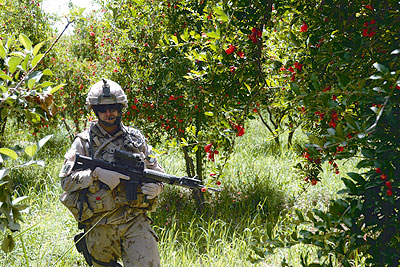
DND photo AR2008-Z139-20
Lieutenant-Colonel Michael J. Goodspeed, an officer in the Princess Patricia’s Canadian Light Infantry (PPCLI), is currently Senior Staff Officer Lessons Learned at the Canadian Defence Academy in Kingston.
Notes
- General Sir Rupert Smith, The Utility of Force: The Art of War in the Modern World (London: Allen Lane, 2005).
- Max Boot, War Made New: Technology, Warfare, and the Course of History: 1500 to Today (New York: Gotham, 2006).
- Apart from these vulnerabilities, if one casts an eye to the future, ‘mass’ could well be added to this list, as the factionalized West may well find it has difficulties maintaining its current technological lead over cultures whose populations are more numerous, and who, as a result of their demographic advantage, prove capable of devoting correspondingly greater efforts in the fields of education and scientific research. “Mass” in a future military context could well take on a new meaning and have more to do with the scale of scientific and technical advantage than the deployment scales of weapons and troops. The possession of knowledge, an ephemeral advantage at the best of times, is now a Western strength, but it could conceivably morph into being a critical vulnerability.
- See also Martin van Creveld, The Rise and Decline of the State (Cambridge, MA: Cambridge University Press, 1999), and The Changing Face of War: Lessons of Combat, from the Marne to Iraq, (New York: Random House 2007), as well Through a Glass Darkly, (Annapolis, MD: Naval War College Review, Autumn 2003).
- John Keegan, The Face of Battle (London: Pimlico, 1976).
- Some might argue that Jihadists have already been given a haven in that the revolutionary Shiite regime in Iran has provided Jihadist terrorists the support of an established state sponsor. Similar arguments have also been made regarding Libya, the Sudan, Yemen, Algeria, Pakistan, and others. The analogy with the Soviet Union and the Cold War may also prove to be fitting from the perspective of nuclear armed states being able to export terror and violent revolution with relative impunity.
- Hammes, Col Thomas X, The Sling and the Stone: On War in the 21st Century (St. Paul, MN: Zenith Press, 2004). Reviewed in CMJ Vol. 7, No. 1, Spring 2006
- Some have argued that Hammes’s definition of Fourth Generation Warfare bears a striking resemblance to Total War, which harnessed every dimension of the state in the pursuit of its war aims. This may be true, but Hammes’s argument goes beyond this concept and is rooted in the new capabilities afforded by readily available technology.
- Several prominent writers have taken exception with this. For an articulate and well-reasoned opposing view see Antulio J. Echevarria, Fourth-Generation War and Other Myths (Carlisle Barracks, PA: Strategic Studies Institute of the US Army War College, November 2005).
- See Alvin and Heidi Toffler, War and Anti-War: Survival at the Dawn of the 21st Century (Darby, PA: Diane Publishing, 1998).
- See William Lind, William S. Lind: The Sling and the Stone, at <www.military.com>.
- Richard E. Simpkin, Race to the Swift: Thoughts on Twenty-First Century Warfare (London: Brassey’s Defence, 1985).
- See Goldwater-Nichols Act of 1986, (Legal Information Institute, Cornell Law School), at <http://www.au.af.mil/au/awc/awcgate/congress/title_10.htm>.
- Ralph Peters, “Progress and Peril,” in Armed Forces Journal (Springfield, VA: Army Times Publishing Company, February 2007).
- The notion of cultivating a ‘warrior’ spirit has probably been an unfortunate one to adopt as the concept of ‘soldier’ has always included the notions of pride, discipline, devotion to duty, sensible aggression, competence, and thinking skills, without trying to conceal or to ‘soft pedal’ the implications of using force. Equally as important, the term ‘soldier’ does not have any of the restrictive connotations implied by the term ‘warrior.’
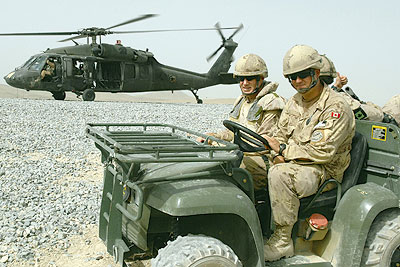
DND photo AR 2008-M060






